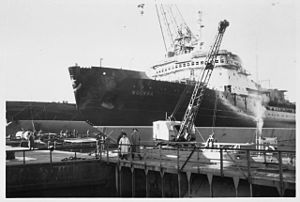 Moskva under construction at Wärtsilä Hietalahti shipyard
| |
| History | |
|---|---|
| Name | Moskva (Москва) |
| Namesake | Moscow |
| Port of registry | Vladivostok, Russia |
| Ordered | 24 May 1956 |
| Builder | Wärtsilä Hietalahti shipyard, Helsinki, Finland |
| Yard number | 365 |
| Launched | 10 January 1959 |
| Completed | 1960 |
| In service | 1960–1992 |
| Identification | IMO number: 5242495 |
| Fate | Broken up in 1992 |
| General characteristics | |
| Class and type | Moskva-class icebreaker |
| Displacement |
|
| Length | 122.10 m (400.6 ft) |
| Beam | 24.50 m (80.4 ft) |
| Draught |
|
| Installed power | 8 × Wärtsilä-Sulzer 9MH51 (8 × 3,250 hp) |
| Propulsion |
|
| Speed | 18 knots (33 km/h; 21 mph) |
| Crew | 109 |
| Aviation facilities | Helideck and hangar |
Moskva (Russian: Москва; literally: Moscow) was a Soviet polar icebreaker and the lead ship of a series of five diesel-electric icebreakers named after major Soviet cities. She was built at Wärtsilä Hietalahti shipyard in Helsinki, Finland, in 1959 and when delivered was the largest and most powerful non-nuclear icebreaker ever built. Shortly after the dissolution of the Soviet Union, Moskva was decommissioned after a long and successful career along the Northern Sea Route and sold for scrap in 1992.
In February 1985, Moskva became the center of international attention when a pod of beluga whales was trapped by ice near the Chukchi Peninsula in the Soviet Far East. The icebreaker broke a channel through the ice pack and managed to lead about 2,000 whales to the open sea.